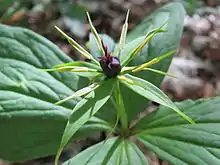Paris (plant)
Paris is a genus of flowering plants described by Linnaeus in 1753.[2][3] It is widespread across Europe and Asia, with a center of diversity in China.[1][4][5][6]
| Paris | |
|---|---|
 | |
| Paris quadrifolia | |
| Scientific classification | |
| Kingdom: | Plantae |
| Clade: | Tracheophytes |
| Clade: | Angiosperms |
| Clade: | Monocots |
| Order: | Liliales |
| Family: | Melanthiaceae |
| Tribe: | Parideae |
| Genus: | Paris L. |
| Species | |
|
See text | |
| Synonyms[1] | |
| |
It consists of less than two dozen herbaceous plants: the best known species is Paris quadrifolia. Some Paris species are used in traditional Chinese medicine for their analgesic and anticoagulant properties, most notably as an ingredient of Yunnan Baiyao. Intense ethnopharmaceutical interest has significantly reduced their numbers.[7]
These plants are closely related to Trillium, with the distinction traditionally being that Trillium contains species which have trimerous (three-petaled) flowers, and Paris contains species which have 4- to 11-merous flowers.[8] A recent analysis places the genera Daiswa and Kinugasa in Paris, though the actual circumscription of the genus is debated.[9]
Etymology
From Latin herba Paris (Herba Paris), Paris herba, from Latin herba and Latin par (“equal”), in reference to the regularity of its leaves, petals, etc. It is neither related to the city Paris nor the Paris of Greek mythology.
Species
The genus consists of the following species:[1]
- Paris axialis – Sichuan, Yunnan
- Paris bashanensis – Sichuan, Hubei
- Paris caobangensis – Vietnam
- Paris cronquistii – Guangxi, Guizhou, Sichuan, Yunnan
- Paris daliensis – Yunnan, Guizhou
- Paris delavayi – Vietnam, Guizhou, Hubei, Hunan, Jiangxi, Sichuan, Yunnan
- Paris dulongensis – Yunnan
- Paris dunniana – Yunnan, Guizhou, Hainan
- Paris fargesii – Arunachal Pradesh, Assam, Bhutan, E Himalayas, N Myanmar, N Vietnam, Guangdong, Guangxi, Guizhou, Hubei, Hunan, Jiangxi, Sichuan, Yunnan
- Paris forrestii – Tibet, Myanmar, Yunnan
- Paris guizhouensis – Guizhou
- Paris incompleta – Turkey, N + S Caucasus
- Paris japonica – Honshu
- Paris luquanensis – Yunnan
- Paris mairei – Guizhou, W Sichuan, N Yunnan
- Paris marmorata – Nepal, Sikkim, Bhutan, Sichuan, Tibet, Yunnan, Assam
- Paris polyandra – Sichuan
- Paris polyphylla – S China, E Himalayas, N Indochina
- Paris quadrifolia – Europe + Asia from Spain + Iceland to Heilongjiang
- Paris rugosa – Yunnan
- Paris stigmatosa – Yunnan
- Paris tetraphylla – Japan
- Paris thibetica – N Myanmar, Assam, Bhutan, Gansu, Guizhou, Sichuan, Tibet, Yunnan
- Paris undulata – Sichuan
- Paris vaniotii – Guizhou, Hunan, Yunnan, N Myanmar
- Paris verticillata – Siberia, Russian Far East, China, Mongolia, Korea, Japan
- Paris vietnamensis – Yunnan, Guangxi, Vietnam
References
- Kew World Checklist of Selected Plant Families
- Linnaeus, Carl von. 1753. Species Plantarum 1: 367
- Tropicos, Paris L.
- Govaerts, R.H.A. (2011). World checklist of selected plant families published update. Facilitated by the Trustees of the Royal Botanic Gardens, Kew.
- Altervista Flora Italiana, Uva di volpe, Paris quadrifolia L. includes photos plus European distribution map
- Flora of China Vol. 24 Page 88 重楼属 chong lou shu Paris Linnaeus, Sp. Pl. 1: 367. 1753.
- Chun-Lin Long; Heng Li; Zhiqin Ouyang; Xiangyun Yang; Qin Li & Bruce Trangmar (2002). "Strategies for agrobiodiversity conservation and promotion: a case from Yunnan, China". Biodiversity and Conservation. 11 (6): 1146–1154. doi:10.1023/a:1023085922265. S2CID 19806957.
- Susan B. Farmer & Edward E. Schilling (2002). "Phylogenetic analyses of Trilliaceae based on morphological and molecular data". Systematic Botany. 27 (4): 674–692. doi:10.1043/0363-6445-27.4.674 (inactive 1 August 2023).
{{cite journal}}: CS1 maint: DOI inactive as of August 2023 (link) - Yunheng Ji; Peter W. Fritsch; Heng Li; Tiaojiang Xiao & Zhekun Zhou (2006). "Phylogeny and classification of Paris (Melanthiaceae) inferred from DNA sequence data". Annals of Botany. 98 (1): 245–256. doi:10.1093/aob/mcl095. PMC 2803534. PMID 16704998.